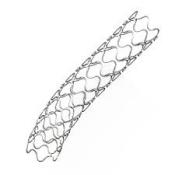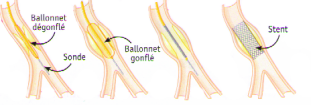VASCULAR.EXPERT
mini-invasives
technics

Marc FITOUSSI M.D
Vascular Surgeon.
18-22 Queen Anne Street
W1G 8HU London
+44 20 7034 3326
VASCULAR.EXPERT

Marc FITOUSSI M.D
Vascular Surgeon.
18-22 Queen Anne Street
W1G 8HU London
+44 20 7034 3326

ANGIOPLASTY STENT
 stent
stent  desilet
desilet 
Balloon dilation with or without a stent is also called endovascular surgery.
WHAT ARE THE ARTERIAL DILATION TREATMENT’S MODALITIES.
- Most often realized percutaneously (without a scar)
- the procedure takes place under local anesthesia. If needed, a general sedation by perfusion will be added.
- puncture of the femoral artery (between the groin and the thigh)
- Use of a desilet
- placement of a catheter sporting an inflatable balloon at its extremity.
The balloon is placed using radiological control near the stenosis (narrower part of the artery), and then inflated thanks to a syringe connected to manometer (measuring pressure). The balloon is then removed..
- Installation of a stent: Usually installed at the same time as the balloon (but not always), an endoprosthetic (stent) is a metal wiring left in the artery keeping it widely spread.
- Removal of the desilet
- a compression bandage is kept on until the following day.
- The length of hospitalization can last from 1 to 2 nights
- As you’re leaving the hospital, your physician will prescribe you an anti-platelets treatment.
- After the surgery, you will still have to make an appointment with your surgeon and with your specialist physician for a control echo-doppler exam.
THE RESULTS
usualy the result is good with a permeability of the artery treated.
- Failure because of the impossibility to go through the stenosis with the catheter. This case, rarer and rarer thanks to a considerable improvement of the tools used, must be considered by your physician beforehand. A bypass would then have to be performed, either during the same surgery, either at a later time.
- Restenosis: The artery shrinks again at the same place it was dilated. This “re” stenosis usually occurs the first year after the original surgery and is linked to an “over scarification” process of the artery. The frequency of this occurring is 10 to 15%. The long term (5 years) success rate for the iliac angioplasty surgery is 85% depending on the elimination of risk factors like smoking.
WHAT POSSIBLE COMPLICATIONS CAN OCCUR DURING THIS PROCEDURE?
Despite all the care we give our patients, incidents or accidents can occur. These might be:
- Hematoma near the puncture area (fold between the leg and the groin), potentiated by the use of blood thinners. I case of increasingly serious hematoma, a surgery can be proposed to remediate to it.
- Hemorrhaging caused by a rupture of the artery. This is an exceptionally rare occurrence that can be stopped with the use of an endoprosthesis or a bypass.
- In this cases, the need for a blood transfusion can be necessary and carries a risk of viral transmission (hepatitis, HIV…)
- Thrombosis: The dilated artery can clog itself up because of a dissection mechanism (delamination) of the artery wall. This can be avoided using a stent.
- Embolism: The dilation will cause a breakage of the atheromatous plaque that can be responsible for the transport of little pieces of it into lower limbs arteries. Usually this embolisms are small and do not require any specific treatment. If the embolism is more serious, the surgeon will have to unclog the responsible artery as soon as possible.
- Renal insufficiency
- allergies (urticarial, edema, cardio-vascular shock) are extremely rare 0.1 to 0.3% of cases. Often caused by iodine containing dyes, these symptoms are benign and short lived. Any history of allergic reaction must be reported to your physician during the pre surgical consult.

VASCULAR.EXPERT
mini-invasives technics
18-22 Queen Anne Street W1G 8HU London
+44 20 7034 3326